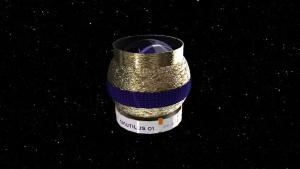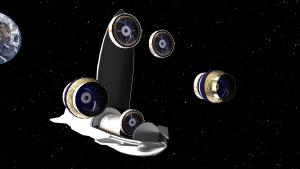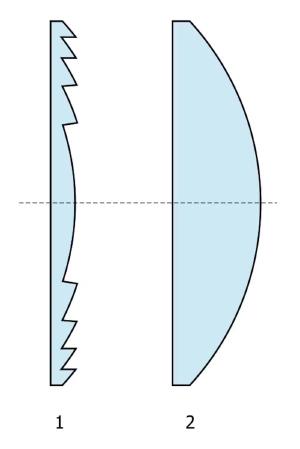Blog
Flat Pack
20 July 2023
 Daniel Apai/University of Arizona
Daniel Apai/University of ArizonaThanks to the laws of physics, there are two basic rules about telescopes. The first is that the bigger your primary lens or mirror, the higher the resolution of your telescope. The second is that lenses and mirrors have to be curved to focus light into an image. So, if you want a space telescope sensitive enough to see the atmospheres of distant exoplanets, Your telescope is going to need a large curved mirror or lens. But neither of these things is technically true, as a newly proposed telescope design demonstrates.1
The requirements for high-resolution telescopes are real, but there are ways to get around them a bit. For example, modern optical telescopes use large mirrors, which are difficult to manufacture in truly large sizes. This is why new observatories use a combination smaller of hexagonal mirrors instead of a single large one. Even the James Webb Space Telescope uses multiple mirrors in tandem. With optical telescopes, the mirrors are all clustered together, but they don’t have to be.
The necessary size of your mirror depends on the wavelengths of light you use. The wavelengths of optical light are on the order of a few hundred nanometers, so even a 4-meter wide mirror gives you a very detailed view of the heavens. Radio wavelengths are much larger, on the order of millimeters to several meters, and a radio mirror would need to be kilometers wide to create a high-resolution image. So modern radio telescopes such as the Atacama Large Millimeter Array (ALMA) use an array of antenna dishes. By combining the data through a process known as correlation, an array can work as a single large virtual telescope. Radio astronomers have used this technique to create the Earth-sized Event Horizon Telescope (EHT), which can observe a supermassive black hole in another galaxy.
 Daniel Apai/University of Arizona
Daniel Apai/University of ArizonaOptical observatories can also use an array of telescopes to create a large virtual one, but the much shorter wavelengths of visible light make it difficult to do on Earth. Even the smallest ground vibration can shift your telescopes out of alignment. But in space vibration isn’t a large problem, so we could build large optical arrays and launch them into orbit. There are several engineering challenges, but one big one is that telescopes with curved lenses or mirrors are heavy, making it cost-prohibitive to launch dozens of them.
Enter the Nautilus Space Observatory (NSO). The proposed mission plans for an array of 35 8-meter telescopes. Working together as a single virtual telescope array, the NSO would be capable of analyzing the atmospheres of more than a thousand Earth-like worlds. Rather than using curved mirrors, each telescope would use a large lens. But instead of using a heavy curved lens, each would use a flat one.
 Wikimedia user Pko
Wikimedia user PkoThis is possible thanks to a physical trick. Although lenses do have to be curved to focus light, it’s only the surface of the lens that does the refraction. You don’t need all the thick material behind the curved surface, so you can just have rings of curved sections with a flat backing. This trick was first popularized by French physicist Augustin-Jean Fresnel and is now called Fresnel lenses. Fresnel lenses were first used in lighthouses, but are now used in everything from overhead projectors to VR headsets. They can be made so thin you can even get ones that are flexible plastic sheets. The reason they haven’t been used in optical astronomy is that their segmented design generally produces images that are too fuzzy for telescopes. The NSO proposal has overcome this challenge by creating a Fresnel lens without fuzzy images.
Rather than simply using ringed sections of a curved lens surface, the new design uses a complex etched pattern on the lens that takes advantage of optical diffraction. As a result, light is focused on a single point, allowing for a sharp image. This design scales, so that large lenses can still be flat and lightweight.
Using this lens design, the NSO telescopes can be much lighter than conventional space telescopes. The telescopes can also be folded into a flatpack so that dozens of telescopes could be launched at once, making the observatory cost-effective. It will be decades before the Nautilus Space Observatory could be built and launched. But this proposal shows that in the future space-based telescope arrays will be a powerful tool for astronomers.
Apai, Dániel, et al. “A thousand earths: a very large aperture, ultralight space telescope array for atmospheric biosignature surveys.” The Astronomical Journal 158.2 (2019): 83. ↩︎